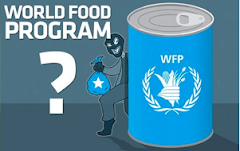
Rose Mutuku talking to farmers in Kitui, eastern Kenya.
Copyright: WFP.
In 2006, Rose Mutuku quit her job at a local brewery to set up Smart Logistics Solution Ltd. What sets Smart Logistics apart from many other traders is that its business model is built around creating partnerships with smallholder farmers. Rose has a passion for rural development because she became tired of seeing farmers in poverty despite all their hard work, she says.
In the beginning, Rose’s small-scale business mainly bought sorghum from farmers and then sold it to a brewery. Over time, she found more buyers and diversified the commodities that Smart Logistics deals with. Currently, the company trades in maize, cowpeas, soya beans, chili and passion fruits.
In addition to 11 permanent employees, 17 mobilizers work for the company in various locations in Kenya’s Eastern Province. The mobilizers are paid on commission basis based on the volume of commodities they buy from smallholders.
Storage
Through a grant from the Market Linkages Initiative (MLI), Smart Logistics has managed to build seven village aggregation centers (VAC) each with a capacity of 200 tons. The aggregation centers will be used by smallholders to bulk their produce and shall be managed by village committees. Each village aggregation center is equipped with a moisture meter, pallets and weighing machines. Three out of the seven centers also have stitching machines, collapsible drier bags and sieves. Smart Logistics has also constructed a grain bulking center with a capacity of 10,000 tons, and plans to establish a laboratory within the center for quality testing
Marketing
In 2010, 3,000 farmers from 135 farmer organizations sold their sorghum to Smart Logistics. To ensure quality, the company sensitizes farmers on quality issues together with the Ministry of Agriculture and other partners. Smart Logistics sells all commodities bought from farmers as soon as they are aggregated. The company currently has four major buyers namely East Africa Breweries for sorghum, Promasidor and Bidco for soya beans and WFP for sorghum, beans and maize.
Smart Logistics secures long term contracts over two to five years with its buyers. Based on these contracts, it enters into an agreement with organized farmers to produce the required commodities. The hired mobilizers discuss the price to be proposed to buyers together with the farmers: they project what it will take the farmers to produce and prepare the commodity for the market, add profit for the farmer, then add 1.50 Shillings per kg for Smart Logistics’ profit.
Smart Logistics therefore makes its profit on volumes - and this is why long term contracts with buyers are so important to Rose, as they allow her company to plan ahead. Another unique feature of Smart Logistics is that unlike other traders, Rose’s earnings are based on commission rather than on market speculation.
Selling to WFP
Rose had four contracts with WFP over the last 2 years. The first contract was awarded through an open tender in 2010, and she supplied 53 tons of sorghum. In 2011, the company received three forward delivery contracts of 112, 56 and 51 tons of maize, sorghum and beans. Delivery for these contracts is expected to be completed by the end of the year. Using the contracts, Rose has secured credit from input suppliers (inputs are provided to farmers and recovered from the sales) as well as from banks: In 2011, the company managed to secure a bank loan of three million Kenya shillings (US$32,000).
Challenges
Smart Logistics faces a number of challenges. At the moment, the biggest is the drought in many parts of Kenya, as many farmers were unable to produce enough food to sell. Price volatility also negatively affected the company’s ability to supply maize and beans. In the future, the company plans to be a regional provider of raw materials to manufacturers and start with value addition of commodities through primary manufacturing – another key step to connect farmers to markets in Kenya.



